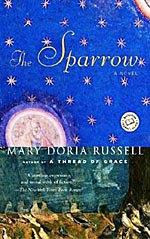
![]() FeminineFantastique
FeminineFantastique
4/1/2014
![]()
Mary Doria Russell's 1996 debut The Sparrow is one of the most celebrated science fiction novels of my lifetime. For this reason, I almost didn't review it; what could I possibly bring to the table? But then I realized that I do have something, which is that the protagonist of this book has a disability that is strikingly similar to mine. And besides, how many books have ever made me both laugh and cry?
The Sparrow opens with two narrative threads — one at the end and one at the beginning, both steadily marching toward the climax. By virtue of the narrative structure, in which both plot threads are linked only by the central protagonist Edward Sandoz, you know the fate of most of the characters within a few pages. It becomes clear that at some point Sandoz, Puerto Rican priest and linguist, underwent a transition, because he seems like two different men in the two halves of the story — he transforms from reverent and energetic to despondent and almost feral. So the reader also knows this:
Something terrible happened on Rakhat.
Rakhat is the planet on which humans first discovered signs of alien life via radio transmission in the year 2016. News of the unearthly, distinctly non-human songs are met with both skepticism and excitement on Earth. Governments meet, collude, and argue; meanwhile, the Jesuits plan and execute a mission. Against almost impossible odds, the Catholic Church assembles a team and a spacecraft…
Perhaps it's a mission guided by God.
Or perhaps not.
Because of the terrible things that happened on Rakhat, the first that the reader learns, one that is visceral and symbolic, is that Edward Sandoz' hands have been mutilated. The usefulness of the appendages that separate us from most other mammals has been taken away from him.
Russell renders this handicap skillfully. I know this because I, like Sandoz, have only marginally useful hands. I was born with a very rare birth defect, thumb hypoplasia; it somehow escaped the notice of healthcare professionals until I was about twelve years old, at which point it had degenerated to the point that I could no longer write longhand. By the age of thirty, I could no longer hold a coffee cup — just like Sandoz.
Like Sandoz, my right hand sometimes generates so much pain that it wakes me up in the middle of the night; like Sandoz, I rarely complain; like Sandoz, I've had my fair share of useless braces fitted over the years, only to be discarded after a few weeks; like Sandoz, I often have too much pride to ask for help.
But these, the hands, are only the beginning. Sandoz arrives back on Earth a man who has been spiritually, emotionally, and mentally broken.
His hands cannot be healed, but perhaps his spirit can.
And this is where the author shines. It's not just her insights into anthropology that makes this novel great: for how could other intelligent, verbal bipeds arrange their social structures given a different environment and planetary species makeup? is one of the questions this novel gives an answer to. But The Sparrow also includes keen insights into human nature: the former prostitute who observes that it was the clients who cried on her shoulder that were most likely to try to kill her. The orphaned adults who look to a middle-aged childless couple in their midst as surrogate parents.
The saintly Jesuit who underwent something so horrible as to lose his faith.
I am too close to this story to give it an objective review. But it did make me laugh and cry, in some of my darkest hours.
There are stories that make you want to punch something and kiss the universe at the same time, and this is one of them. Just read it, and weep, and laugh.
And know that you are just like me, or Sandoz.
http://manicpixiedreamworlds.wordpress.com/